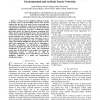DMSN
2005
ACM
14 years 1 months ago
2005
ACM
In the resource over-constrained environment of sensor networks, techniques for storing data locally in sensor nodes have been proposed to support efficient processing of adhoc qu...
DIALM
2005
ACM
14 years 1 months ago
2005
ACM
The identification of holes in a wireless sensor network is of primary interest since the breakdown of sensor nodes in a larger area often indicates one of the special events to ...
IPSN
2010
Springer
14 years 1 months ago
2010
Springer
In-network processing is recommended for many sensor network applications to reduce communication and improve energy efficiency. However, constraints on memory, speed, and energy ...
CF
2005
ACM
14 years 1 months ago
2005
ACM
Network intrusion detection systems (NIDS) are becoming an increasingly important security measure. With rapidly increasing network speeds, the capacity of the NIDS sensor can lim...
APWEB
2006
Springer
14 years 1 months ago
2006
Springer
Applications of sensor networks have become an emerging technology which can monitor a specific area and collect environmental data around the district. The energy of sensor nodes ...
MOBISYS
2007
ACM
14 years 1 months ago
2007
ACM
— Perhaps the most significant challenge in design of on-body sensors is the wearability concern. This concern requires that the size of the nodes (sensors, processing units and ...
CSE
2009
IEEE
14 years 2 months ago
2009
IEEE
A lifetime of several years for wireless sensor nodes can be achieved if their activity period is minimized. This can be done by using low duty cycle protocols. One of the challeng...
ETFA
2006
IEEE
14 years 3 months ago
2006
IEEE
Wireless sensor networks (WSN) consist of small self-contained devices with computational, sensing and wireless communication capabilities. They allow flexible, powerful, tetherles...
DASFAA
2006
IEEE
14 years 3 months ago
2006
IEEE
Sensor networks are multi-hop wireless networks of resource constrained sensor nodes used to realize high-level collaborative sensing tasks. To query and access data generated and ...
DSN
2004
IEEE
14 years 3 months ago
2004
IEEE
Wireless sensor networks face acute security concerns in applications such as battlefield monitoring. A central point of failure in a sensor network is the base station, which act...


